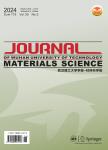Effect of Nano Silica on Hydration and Microstructure Characteristics of Cement High Volume Fly Ash System Under Steam Curing
Effect of Nano Silica on Hydration and Microstructure Characteristics of Cement High Volume Fly Ash System Under Steam Curing作者机构:State Key Laboratory of Silicate Materials for ArchitecturesWuhan University of TechnologyWuhan430070China Department of Construction CostWuhan University of TextileWuhan430200China
出 版 物:《Journal of Wuhan University of Technology(Materials Science)》 (武汉理工大学学报(材料科学英文版))
年 卷 期:2019年第34卷第3期
页 面:604-613页
核心收录:
学科分类:08[工学]
基 金:Funded by the “13th Five-Year” National Science and Technology Support Program of China(No.2016YFC0701003–05) the Science and Technology Support Program of Hubei Province(No.2015BAA084) the National Natural Science Foundation of China(No.51378408)
主 题:nano silica cement high volume fly ash hydration pozzolanic reaction pore structure interfacial transition zone
摘 要:The influences of nano silica (NS) on the hydration and microstructure development of steam cured cement high volume fly ash (40 wt%, CHVFA) system were investigated. The compressive strength of mortars was tested with different NS dosage from 0 to 4%. Results show that the compressive strength is dramatically improved with the increase of NS content up to 3%, and decreases with further increase of NS content (e g, at 4%). Then X?ray diffraction (XRD), differential scanning calorimetry-thermogravimetry (DSCTG), scanning electron microscope (SEM), energy disperse spectroscopy (EDS), mercury intrusion porosimeter (MIP) and nuclear magnetic resonance (NMR) were used to analyze the mechanism. The results reveal that the addition of NS accelerates the hydration of cement and fly ash, decreases the porosity and the content of calcium hydroxide (CH) and increases the polymerization degree of C-S-H thus enhancing the compressive strength of mortars. The interfacial transition zone (ITZ) of CHVFA mortars is also significantly improved by the addition ofNS, embodying in the decrease of Ca/Si ratio and CH enrichment of ITZ.



